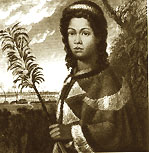- He inoa no ka lani
- No Nahiʻenaʻena
- A ka luna o wahine
- Hoʻi ka ʻena a ka makani
- Noho ka laʻi i ka malino
- Makani ua ha ao
- Ko ke au i hala ea
- Punawai o Mānā
- Wai ola no ke kupa
- A ka ʻīlio nana
- Hae nanahu i ke kai
- Ehu kai nana ka pua
- Ka pua o ka iliau
- Ka ʻohai o mapepa
- Ka moena weʻuweʻu
- I ulana ia e ke aʻe
- Ka naku loloa
- Hea mai o Kawelohea
- Nawai la e ke kapu
- No Naiʻenaʻena
- Ena nā pua i ka wai
- Wai au o Hōlei
- No Nahiʻenaʻena
Princess Nahiʻenaʻena (Raging fire)
Prince Kauikeaouli
- A eulogy for the
princess
- Nahiʻenaʻena
- Chief among women
- She soothes the cold wind with her flame
- A peace that is mirrored in calm
- A wind that sheds rain
- A tide that flowed long ago
- The water spring of Mānā
- Life spring for the people
- Nahiʻenaʻena
- A fount where the lapping
dog
- Barks at the incoming wave
- Drifting spray on the bloom
- Of the sand sprawling iliau
- And the scarlet flower of ʻohai
- On the wind woven mat of wild grass
- Long naku, a springy mattress
- The spouting horn
- Kawelohea, asks
- Who of right has the tabu
- The princess Nahiʻenaʻena
- The flowers glow in the pool
- The bathing pool of Hōlei
- Barks at the incoming wave
Source: Unwritten Literature of Hawaii by Emerson, Library of Congress Catalog Card #65-12971 - This is a kanikau or dirge for Princess Nahiʻenaʻena. Punawai o Mānā is a fresh water spring in Honuʻapo, Kaʻu. ʻOhai is a flowering shrub brought from Kahiki by Nāmakaokahaʻi; Kawelohea was a spouting horn at Honʻapo that ceased action after the volcanic eruption of 1868. Nahiʻenaʻena and Kauikeaouli were the children of Kamehameha I and his sacred (highest spiritual rank) wife, Keōpūʻolani. Princess Nahiʻenaʻena was born about 1815, at Keauhou. She was not hānai at birth, contrary to Hawaiian custom, and was raised by her natural mother. Her name means the raging or glowing fires. From childhood she was expected to marry her brother, Kaiukeaouli. This divine marriage and the issue from it "would mingle sacred blood and establish the eternal kingdom." The second company of missionaries arrived in 1823 and changed her destiny and that of Hawaiʻi. Sept, 1823, Queen mother, Keopuolani, was baptized on her deathbed. Her last wish was her children be raised Christian. The welfare and education of the princess, age 8, was committed to Rev. William Richardson and Rev. Charles Stewart, making Nahiʻenaʻena the center of contradiction and confusion. Marriage of the two sacred children was discussed by the council of high chiefs in September, 1824, but the horrified missionaries forbade such a union although from time immemorial it was a Hawaiian tradition. When Kauikeaouli ascended the throne as Kamehameha III, his sister was banished to Maui. As the king and his sister matured, they planned to marry, a union the chiefs hoped for, in accordance with their culture. Her guardians tried to prevent this incestuous relationship and excommunicated the princess. A victim of her mother's death wish, missionary training, ancient Hawaiian tradition and her passionate, erotic love for her brother, she asked Kauikeouli to release her from her duty. In anguish and grief, the king attempted suicide June of 1934, after Nahiʻenaʻina refused to join him at Puʻuloa. Finally in July, 1934, they were married in the ancient way at the home of High Chief Pāki. In the presence of their guardians Hoapili and his wife, they consumated their marriage. The Hawaiian people were overjoyed but their marriage was not recognized by the Christian community. The only suitable choice of high rank to marry the king, they shared a common childhood, tradition, forced separations, love affairs and censure from the western attitude on incest, in direct conflict with the Hawaiian tradition of sacred marriage. Whatever she did was a sin, trespass or violation of one of the two worlds in which she lived; she was ensnared. Tormented, the princess became ill. Her son, born Sept 17, 1836, lived only a few hours. By December, she was dead taking with her the hope and perpetuation of the Hawaiian nation, her tragic life parelleling the story of her people. Kamehameha III eventually married, but always grieved for his only love, the Princess Nahiʻenaʻena, his sister.

